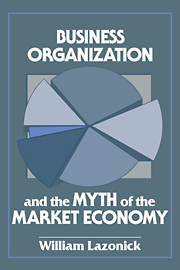Book contents
- Frontmatter
- Contents
- List of figures
- Acknowledgments
- Introduction: the wealth of three nations
- PART I Economic institutions and economic performance
- 1 Institutional foundations of industrial dominance and decline
- 2 Organizations and markets in capitalist development
- 3 Business organization and competitive advantage
- PART II Intellectual foundations and intellectual constraints
- PART III The “marvels of the market” versus the “visible hand”
- PART IV Overcoming intellectual constraints
- Index
3 - Business organization and competitive advantage
Published online by Cambridge University Press: 01 April 2010
- Frontmatter
- Contents
- List of figures
- Acknowledgments
- Introduction: the wealth of three nations
- PART I Economic institutions and economic performance
- 1 Institutional foundations of industrial dominance and decline
- 2 Organizations and markets in capitalist development
- 3 Business organization and competitive advantage
- PART II Intellectual foundations and intellectual constraints
- PART III The “marvels of the market” versus the “visible hand”
- PART IV Overcoming intellectual constraints
- Index
Summary
The value-creating enterprise
A capitalist economy relies on private-sector enterprises to make investments in the technological capabilities that are essential to economic growth. Through its investment activities, an enterprise commits financial resources to specific processes to make particular products with the expectation of reaping financial returns. Once committed, the productive assets of the enterprise represent fixed costs that must then be recouped by the production and sale of its output.
The basic challenge that faces the capitalist enterprise is to transform the fixed costs inherent in its investments into revenue-generating products. To do so, the enterprise must create value: It must produce goods that buyers desire at prices they can afford. Value-creating enterprises are those that can produce high-quality (desirable) products at low unit (affordable) costs.
In a dynamic world economy, competitive standards for high-quality products and low unit costs are constantly changing. For consumer products, the definition of “high quality” depends on the needs and wants of buyers, which in turn depend on a wide array of cultural factors as well as the general evolution of living standards. Both the moral and material bases of consumer preference are to some extent shaped by the activities of the business enterprises that, taken as a whole, service these preferences. For capital goods – products that serve as inputs into the value-creating process – the preferences of buyers are shaped by the organizational and technological requirements of their enterprises.
- Type
- Chapter
- Information
- Business Organization and the Myth of the Market Economy , pp. 92 - 112Publisher: Cambridge University PressPrint publication year: 1992
- 2
- Cited by



